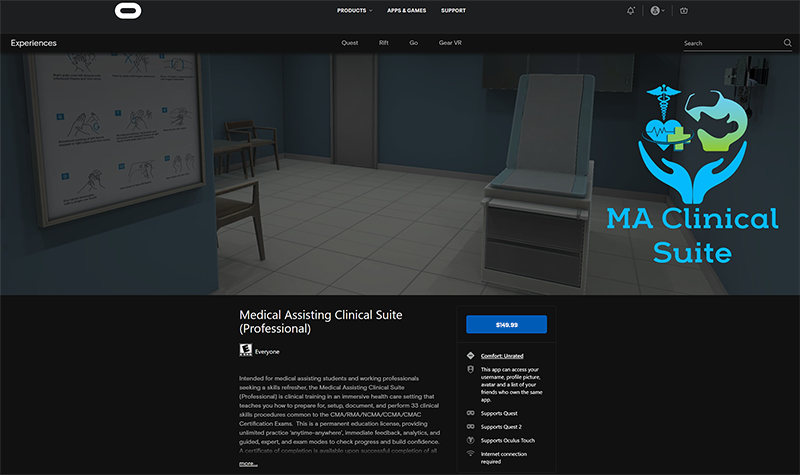A medical assistant may be asked to assist with minor eye injuries or eye treatment. This skill lab teaches you how to prepare for, perform, and document techniques for eye irrigation and to instill eye medication.
This lab is based on the entry-level competencies for which the Commission on Accreditation of Allied Health Education Programs (CAAHEP) and Accrediting Bureau of Health Education Schools (ABHES) test the Medical Assistant.
Learning Sequence Builds Confidence
The learner practices the procedure in the ‘guided mode’ (interaction hints and an expanded checklist guide) as often as they like.
When the learner is confident that they can accurately demonstrate the procedure without error, the learner plays the level in the ‘expert mode’ (no hints or checklist explanations) - which they can repeat as often as they wish.
Finally, when the learner is confident that they have mastered the procedure - they take a one-time ‘exam’ attempt which results in their grade for that procedure.
The Medical Assisting Clinical Suite (Professional) Edition is available for purchase through the Oculus AppLab for $149.99
Features
Guided Mode - ghosted hints show step-by-step positions, learner can 'see through' the patient to verify placement.
Oculus Quest Affordability & Ease of Use - next generation game development processes allow the untethered, mobile VR to present effective visual and interaction fidelity at 1/4 of the cost of desktop VR.
Feedback - Cloud-based enterprise incorporates real-time data acquisition that allows learner to track progress and mastery, and provides detailed insights for debrief with faculty.
Support - Enterprise incorporates Knowledge Base (with tutorial videos & FAQ) - combined with help desk support staff for learners and staff.
Irrigate Eye and Instill Medication Checklist
- Perform hand hygiene.
- Perform 2nd medication check.
- Assist the patient to assume a supine position.
- Cover the patient’s neck and shoulder with a drape or towel.
- Cleanse the eyelashes and eyelids of any drainage or crusting with a warm washcloth or gauze. Use each area of cleaning surface only once and move from inner to outer eye area.
- Place a drainage basin next to the patient’s eye above the drape.
- Using your thumb and forefinger, gently open the patient’s upper and lower eyelids to expose the eye.
- Ask the patient to look up.
- Fill the irrigating syringe.
- Place the tip of the irrigating syringe just above the eye. Depress the bulb or plunger on the irrigating syringe. Direct a slow, steady stream of irrigating solution back and forth across the eye moving from inner to outer until the syringe is empty .
- Dry the patient’s face with a cotton swab.
- Observe the return in the basin and record if needed.
- Tilt patient’s head back slightly if patient is sitting up, or place patient’s head over a pillow (under the neck) if they are lying down.
- Check the label on the ear drop solution against the physician’s order.
- Invert the eye-drop container and have patient look up and focus on something on the ceiling.
- Gently pull patient’s lower lid down, using thumb or two fingers to expose conjunctival sac.
- Eye drops: Hold eye-drop container above eye, taking care not to touch the eye, eyelids, or eyelashes. Instill one drop or more, if prescribed, into conjunctival sac.
- Release lower lid after instillation and ask patient to close eyes gently. Ask patient to move the eyeball while eyes are closed.
- Apply gentle pressure over inner canthus for 30 to 60 seconds to prevent medication from entering the lacrimal duct.
- Instruct patient not to rub eye.
- Remove and discard gloves and assist patient to a comfortable and safe position.
- Perform hand hygiene.
- Document the procedure and findings according to agency policy.

